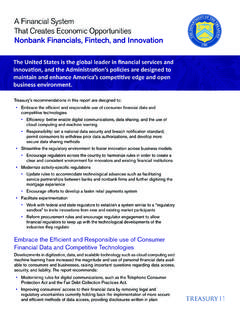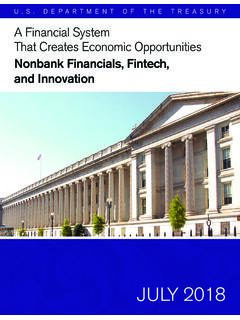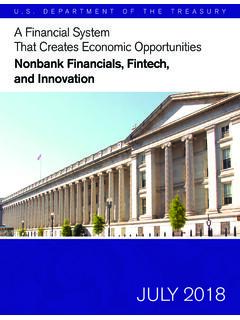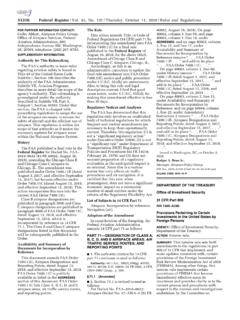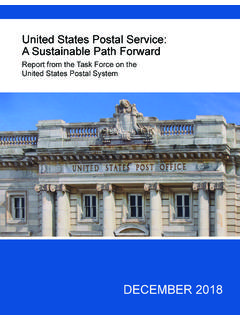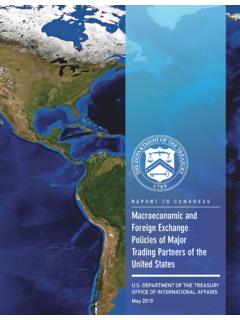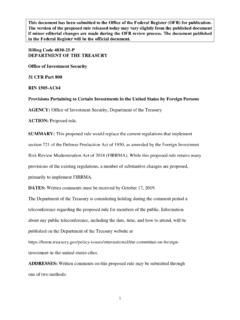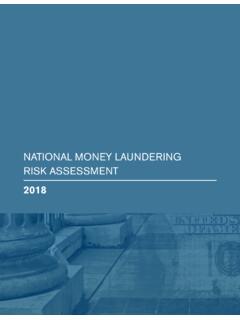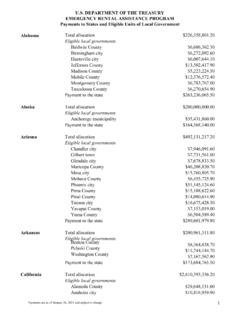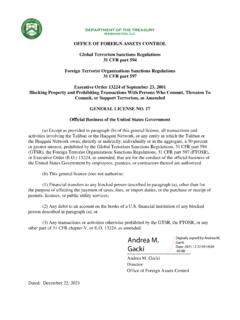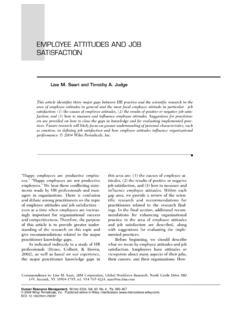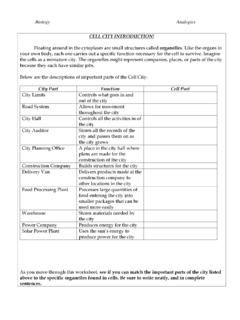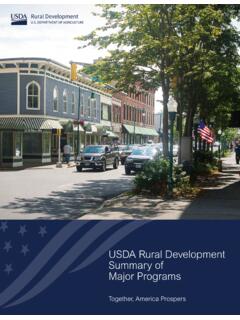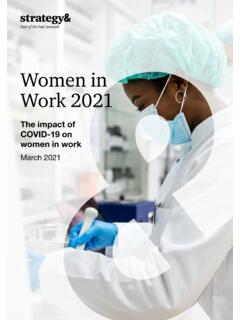Transcription of THE STATE OF LABOR MARKET COMPETITION
1 OF THE TREASURY THE STATE OF LABOR MARKET COMPETITION March 7, 2022 OF THE TREASURY THE STATE OF LABOR MARKET COMPETITION b EXECUTIVE SUMMARY On July 9, 2021, President Biden signed an historic executive order on Promoting COMPETITION in the American Economy. That order underscored the importance of COMPETITION in the LABOR MARKET , stating that a competitive marketplace creates more high-quality jobs and the economic freedom to switch jobs or negotiate a higher wage. The order tasked the Treasury Department, in consultation with the Department of Justice, the Department of LABOR , and the Federal Trade Commission to investigate the efects of a lack of LABOR MARKET COMPETITION on the United States LABOR MARKET . The purpose of the report is to summarize the prevalence and impact of uncompetitive firm behavior in LABOR markets.
2 In particular, the report catalogues the ways in which insuficient LABOR MARKET COMPETITION hurts workers, documents the proliferation of barriers to job mobility, and illustrates how a lack of LABOR MARKET COMPETITION can hold back the broader macroeconomy, while also providing an assessment of the degree to which lack of COMPETITION lowers wages. This analysis is followed by a description of Biden Administration actions to improve COMPETITION , including a commitment by the Department of Justice and Federal Trade Commission to vigorously enforce antitrust laws in LABOR markets. In discussing the MARKET characteristics that enable monopsony power, this report describes how monopsony power emerges when a single firm can restrain its hiring to lower wages and boost profits. While most LABOR markets do not literally feature a single employer, a MARKET with a small set of employers may mimic a monopsony by each engaging in practices that give them MARKET power over workers.
3 Concentration in particular industries and locations can lead to workers receiving less pay, fewer benefits, and worse conditions than what they would under conditions of greater COMPETITION . There is also increasing recognition that MARKET power may be inherent in the firm-worker relationship. Much of the theory of LABOR markets and wage setting is premised on the idea that individual workers and firms search for one another, seek and find matches that maximize productivity and wages, and bargain over employment terms. Workers ofen find themselves at an informational disadvantage relative to firms, not knowing what other, similarly placed workers earn, the competitive wages for their LABOR , or the existence of workplace problems like discriminatory conduct or unsafe working conditions. Workers also may have a limited or no ability to switch locations and occupations quickly and may lack the financial resources to support themselves while they search for jobs that pay more and better match their skills and abilities.
4 These conditions can enable firms to exert MARKET power, and consequently ofer lower wages and worse working conditions, even in LABOR markets that are not highly concentrated. The report details the range of practices that firms use to restrain COMPETITION for workers, most clearly to lower wages and benefits, but also potentially to negatively impact job characteristics beyond just compensation. Firms can engage in tacit collusion by sharing wage information for diferent occupations, conspiring to fix wages, adopting no-poach agreements where firms agree not to hire other firms workers, or forcing workers to sign non-compete agreements that limit their ability to switch jobs . Non-disclosure agreements can be so broad as to efectively operate as non-compete agreements. Mandatory arbitration agreements prevent workers from legal recourse to rectify violations of LABOR laws, antitrust laws, or employment terms.
5 Lack of pay transparency, from firms use of salary history, pay secrecy, and punitive practices against workers sharing pay information, also restrains COMPETITION . A growing literature in economics seeks to measure the LABOR MARKET power exerted by firms over workers. As David Card, the most recent recipient of the Nobel Prize in Economics, stated in his presidential address to the American Economic Association, I will try to make the case that the time has come to recognize that many or even most firms have some wage-setting power. Measuring the extent of LABOR MARKET power can be challenging, as it requires extensive insight into the THE STATE OF LABOR MARKET COMPETITION i THE STATE OF LABOR MARKET COMPETITION relationship between firms and workers that goes beyond standard measures collected. As this report highlights, a careful review of credible academic studies places the decrease in wages at roughly 20 percent relative to the level in a fully competitive MARKET .
6 In some industries and occupations, like manufacturing, estimates of wage losses are even higher. Wage-setting power is also evident in the large number of workers who are subject to rules and agreements that limit their ability to switch jobs and occupations and, hence, their bargaining power. For example, a recent paper estimates that one-in-five workers is currently subject to non-compete agreements and double that number report having been bound by a non-compete agreement in the past. As the report discusses, many workers are also subject to excessive occupational licensing requirements that impede their ability to switch jobs across states or their ability to enter a new occupation. The report also highlights the ways in which employers alter the structure of their own work relationships to lower their LABOR costs and undercut COMPETITION at the expense of workers.
7 The LABOR MARKET has become fissured, a wide variety of roles ranging from cafeteria workers and janitors to lawyers that were once in-house are now contracted out. This domestic outsourcing is estimated to reduce wages from 4 percent to 24 percent in some industries and occupations. Moreover, when firms misclassify workers, they ofload LABOR costs and risks onto workers for example, by avoiding unemployment insurance taxes and workers compensation premiums and make it dificult for workers to organize or join a union and bargain collectively for better wages and conditions. The decline in union density rates further weakens workers bargaining power, leaving them with less ability to counterbalance firms wage setting power. The impacts of insuficient LABOR MARKET COMPETITION ofen fall hardest on women and workers of color, who make up a larger share of workers in lower-paid occupations.
8 These workers ofen have diminished bargaining power because they lack the resources to easily switch jobs or occupations, to reject or negotiate against signing restrictive employment agreements, or to seek legal recourse for violations of LABOR and employment law. The report also highlights the ways in which a lack of LABOR MARKET COMPETITION can impact the broader economy. Lack of LABOR MARKET COMPETITION contributes to high levels of income inequality, diminishes incentives for firms to invest, inhibits the creation and expansion of new firms, and reduces productivity growth through lower reallocation of LABOR across firms and industries. The Biden Administration is committed to promoting robust COMPETITION in LABOR markets and has directed a government-wide efort to support LABOR MARKET COMPETITION . The Department of Justice and Federal Trade Commission are committing to the vigorous enforcement of antitrust laws in LABOR markets, to combat anticompetitive agreements, conduct, or mergers.
9 The Administration has called on Congress to raise the minimum wage and support increased worker power through increased organizing and collective bargaining facilitated by the Protecting the Right to Organize Act and other legislation. The President s Task Force on Worker Organizing and Empowerment recommended 70 actions that executive branch agencies and departments will implement to facilitate greater union organizing and collective bargaining. As part of his Executive Order on COMPETITION , the President encouraged the Federal Trade Commission to consider banning or limiting the use of non-compete agreements. The President s Executive Order increasing the minimum wage for federal employees and contractors raised wages for more than 300,000 private-sector employees and 70,000 federal employees. Finally, in addition to education, compliance assistance, and enforcement of workplace laws, the Department of LABOR s administrative actions include addressing worker misclassification, supporting worker organizing, and working to improve job quality, including access to jobs with higher wages and better working conditions.
10 Ii THE STATE OF LABOR MARKET COMPETITIONT able of Contents 1 Theories of LABOR MARKET Power .. 3 Pure Monopsony ..4 Monopsonistic Search and Matching Models of LABOR Racial Inequality under Search and Matching Frictions .. 7 Platforms/Regulatory Fissuring of the Fissuring Considerations .. 10 Misclassification of 11 Restrictive Employment Agreements and No-Poach Heterogeneity in Enforcement and Legality of Restrictive 14 Theory .. 15 Mandatory Pre-Dispute Arbitration and Class Action Waivers ..18 Occupational Skill-Biased Technical Change and Job LABOR MARKET Power & COMPETITION : Empirical Evidence .. 23 Does LABOR MARKET Power Suppress Wages, in Practice?..23 The Extent of Wage Losses due to LABOR MARKET Changes in LABOR MARKET Power and Concentration over Alternative Perspectives on MARKET Concentration and LABOR MARKET Restrictive Employment Trends in and Effects of Occupational Licensing.
